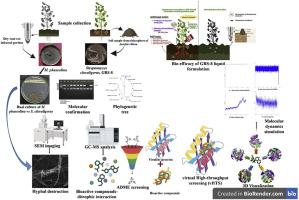探讨根际锁骨链霉菌对花生干腐病病原菌菜绿巨霉的生物活性潜力。
IF 3.5
3区 医学
Q3 IMMUNOLOGY
引用次数: 0
摘要
花生干根腐病是一种严重危害花生生产的土传真菌病。本研究以链霉菌clavuligerus GRS-8为研究对象,从多方面研究了链霉菌根际的生防和植物促生潜力。体外双培养实验表明,GRS-8抗真菌活性最高,对菜绿支原体菌丝生长的抑制率为76.50%。该菌株还产生关键代谢物,包括吲哚-3-乙酸、铁载体和水解酶,有助于促进植物生长和防御启动。在硅分子对接中,奎宁酮肟是一种有效的生物活性化合物,与菜绿分枝杆菌的5种毒力相关蛋白具有高结合亲和力。分子动力学模拟证实了脂肪酶-醌肟复合物的结构稳定性,支持其作为真菌抑制剂的潜力。在保护栽培条件下,通过种子处理、基施和土壤淋施组合施用GRS-8液体制剂可显著降低干根腐病发生率73.10%,提高寄主防御酶活性。这些发现突出了S. clavuligerus GRS-8的双重作用机制,包括直接抗真菌作用和诱导寄主防御作用,强调了其作为花生可持续种植生物防治剂的潜力。本文章由计算机程序翻译,如有差异,请以英文原文为准。

Exploring the bioactive potential of rhizospheric Streptomyces clavuligerus against Macrophomina phaseolina, an incitant of groundnut dry root rot disease
Dry root rot caused by Macrophomina phaseolina is the most destructive soil-borne fungal disease that severely hampers groundnut production. This study investigated the multifaceted biocontrol and plant growth-promoting potential of rhizospheric Streptomyces spp., focusing on the strain Streptomyces clavuligerus GRS-8. In vitro dual culture assays revealed that GRS-8 exhibited the highest antifungal activity, inhibiting 76.50 % of M. phaseolina mycelial growth. The strain also produced key metabolites, including indole-3-acetic acid, siderophores, and hydrolytic enzymes, contributing to plant growth promotion and defense priming. In silico molecular docking identified quininone oxime as a potent bioactive compound with high binding affinity to five virulence-associated proteins of M. phaseolina. Molecular dynamics simulations confirmed the structural stability of the lipase–quininone oxime complex, supporting its potential as a fungal inhibitor. Under protected cultivation, the combined application of GRS-8 liquid formulation via seed treatment, basal application, and soil drenching significantly reduced dry root rot incidence by 73.10 % and enhanced the activity of host defense enzymes. These findings highlight the dualistic mechanism of S. clavuligerus GRS-8 involving direct antifungal action and host defense induction, underscoring its potential as a promising biocontrol agent for sustainable groundnut cultivation.
求助全文
通过发布文献求助,成功后即可免费获取论文全文。
去求助
来源期刊

Microbial pathogenesis
医学-免疫学
CiteScore
7.40
自引率
2.60%
发文量
472
审稿时长
56 days
期刊介绍:
Microbial Pathogenesis publishes original contributions and reviews about the molecular and cellular mechanisms of infectious diseases. It covers microbiology, host-pathogen interaction and immunology related to infectious agents, including bacteria, fungi, viruses and protozoa. It also accepts papers in the field of clinical microbiology, with the exception of case reports.
Research Areas Include:
-Pathogenesis
-Virulence factors
-Host susceptibility or resistance
-Immune mechanisms
-Identification, cloning and sequencing of relevant genes
-Genetic studies
-Viruses, prokaryotic organisms and protozoa
-Microbiota
-Systems biology related to infectious diseases
-Targets for vaccine design (pre-clinical studies)
 求助内容:
求助内容: 应助结果提醒方式:
应助结果提醒方式:


